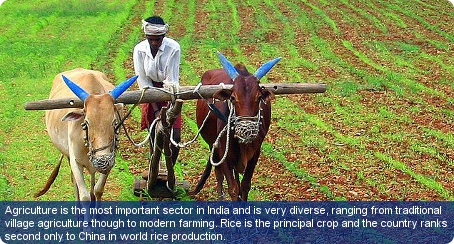Find a business in India

The Indian economy is one of the biggest in the world and is rapidly increasing in size each year. In 2010 it ranked ninth worldwide in terms of GNI after a GDP growth rate of 8.4% per annum in 2006-10 – the GDP growth is now 6.5% per annum 2008-12. This has contributed to increasing its GNI per capita to US$1,580 in 2012 for the 1.2 billion population. India is one of the world’s largest industrial economies with vast reserves of oil and gas, but there is still a considerably large agriculture sector which dominates the rural economy. In the late 1990s and 2000s, India enjoyed strong export-led growth and with a large proportion of English speakers, the IT, software, and services sector has seen rapid growth in the last decade.
The economy of India is extraordinarily diverse, ranging as it does from traditional village agriculture through modern farming, crafts, light and heavy industry, chemicals and a wide variety of service industries. Agriculture together with forestry and fisheries contribute 19% of India’s GDP (2010) and is still important in the rural economy, although it plays a declining role in the national economy. Its share in overall GDP fell from 30% in the early nineties, to 19% in 2010. Likewise agriculture is the major source employment for around 60% of the labour force (2007), but also down from 70% in the early nineties with country. All this has been a result of the country’s rapid economic growth and diversification into the services and manufacturing areas of the economy, as well as the process of urbanisation.
Manufacturing contributes 16.1% of India’s GDP (2008). India is of the world’s leading producers of textiles, plastics, pharmaceuticals, computer software and steel. It has among the lowest labour costs in the world which along with its stable political, social and economic environment has made it an attractive investment destination.
Mining is a major contributor to the Indian economy, with over 1.1 million people employed by it and minerals forming 16% of the country’s exports (2006). The mining industry is dominated by coal mines, which contribute around 80% of total output, with the other 20% being taken up by many various metal and mineral mines such as copper, zinc and iron (2006). India has 5.682 billion barrels of proven oil reserves and 64.95 billion cubic metres of proven natural gas reserves (January, 2011 estimate). This wealth of natural resources is expected to keep economic growth high in the next few years.
India is a net importer of goods and services, running at 8% of GDP (2010), and the value of its imports are estimated to be around $327 billion. Its exports total $201 billion (2010), which gives the country a trade deficit of $126 billion.
India’s transport sector is very large and diverse, and under an ever increasing demand. Around half of the roads in India are paved. The country has 5,600km of coastline and therefore coastal shipping of freight within India plays an important role. There are several international airports across the country.
India is ranked 132nd in the world for the ease of doing business, according to the World Bank’s ‘Doing Business 2012’ study. But it is ranked first in the South Asian region for getting credit and second for getting electricity. These rankings measure the conduciveness of a regulatory regime in starting and operating a business.
India has a 62.8% literacy rate (2006). English is the subsidiary official language, whilst the other, Hindi, is the most widely spoken language. The total labour force numbers 478.3 million (2010), with 52% employed in agriculture and 34% in services (2009). However, according to The Economic Times, 93% of all employment is from within the unorganised sector (2011).



